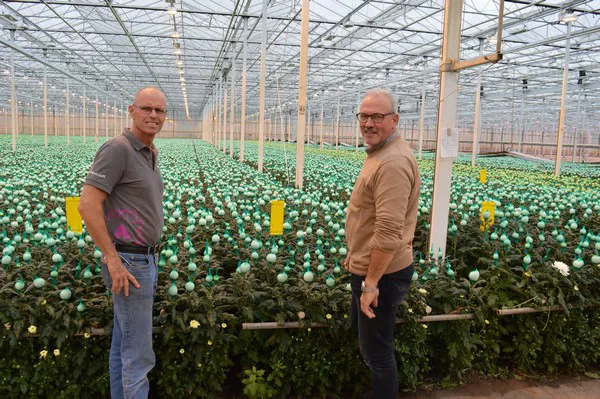In general, chrysanthemum growers get through the first 8 or 9 months well with organic cultivations. It is in the last few months, in winter, that they often resort to spraying. The climate gets worse, the organic side is less active and so they often do 'a round of chemicals'. But because legislation and regulations are becoming stricter and the range of products available is getting tighter, the challenge is becoming greater all the time.

André van Paassen and Martien Mellisant
Oroganic, a natural crop protection agent based on orange oil, offers a solution. The product has had approval for indoor cultivation for eighteen months and since then it has been used in various crops. It is a contact agent with a broad spectrum of activity, but it is not a 'killer' or a 'fire-extinguisher'; a young thrips or aphid is effectively killed, but if adult thrips or aphids are all over the plant, you can no longer reach them and you are too late. It should be sprayed along with the water and/or any other agent, such as Vertimec (which is often used in chrysanthemums). It draws the agent through the layer of wax on the leaf into the plant, while at the same time turning a droplet into a film, explains Martien Mellisant, sales manager at producer Oro Agri.
A clean start is half the battle
A clean start is everything, knows André van Paassen, one of Arcadia's growers and the manager at the company in De Kwakel. He grows a broad spectrum of fluff chrysanthemums in two adjacent blocks of four hectares each. This gives him the opportunity to experiment, in crop protection but also in all other aspects of cultivation, because he always has a good reference. This is how he started with Oroganic, which he introduced for the first time along with Vertimec in the autumn of 2019.
Brilliant results have been achieved with organic methods, André knows. Thrips in particular are excellently tackled with montdorensis, 'little soldiers' that attack the thrips like an 'army'. If the thrips pressure increases, you have to introduce more soldiers. "In the past, when chrysanthemum growers spoke of issues, 50% of the time it was about thrips. That's simply not an issue anymore."
It's different with, for example, spider mite, which often rears its head in winter. "There are growers who go through the winter fully organically, but the effectiveness is less in these cases. If you then do a chemical round, you have to remain vigilant for red spider mite. However, we think that the combination of Vertimec-Oroganic makes it possible to stop using other spider mite agents. So far, so good."
Resistance breaker
Leaving aside the nuances, the same can be said for aphids and bugs. The range of products is getting tighter, so much so that for aphids in combination with biology only one product (Teppeki) is actually available. "You see, however, that the effectiveness decreases, because that is the case for all agents that are used endlessly. You can therefore also see Oroganic as a resistance breaker", Martien says. "By mixing these agents, you prevent resistance and broaden the effect of the spraying."
In one of the two cultivations André has now used considerably less chemicals throughout the year. "In the chrysanthemum business, we are used to using the sprayer every now and then. That is a kind of insurance, cleaning up everything thoroughly, which gives a good feeling. In the beginning, you have a small plant and you can reach everything easily; if there is a full crop and the pest pressure increases, then you are too late. Oroganic combines well with the biological control agents, and where those fall short and a round of chemicals is still necessary, you can get by with considerably less."
For more information:
Oro Agri
Martien Mellisant
[email protected]
www.oroagri.eu
Arcadia Chrysanten
André van Paassen
www.arcadiachrysanten.nl
